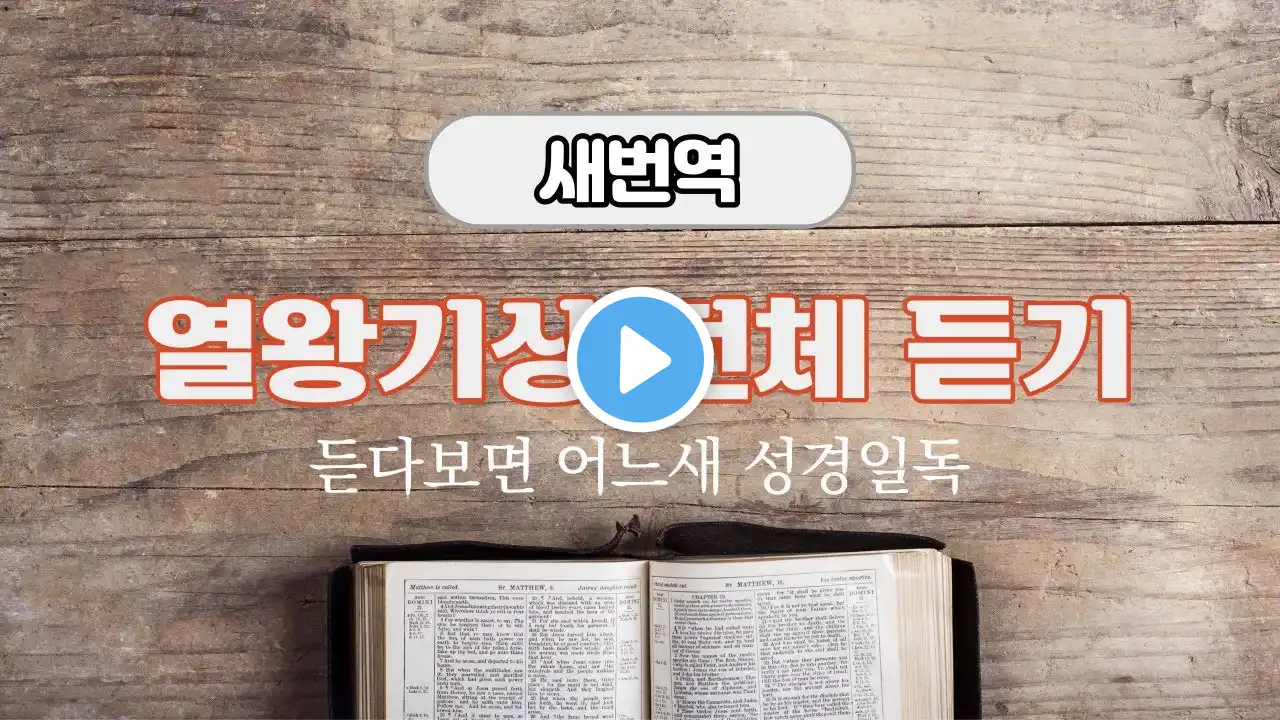![[새번역 성경] 열왕기하 1-25장 [Book of 2 Kings] 여호와 앞에서 언약을 세우되 마음을 다하고 뜻을 다하여 여호와께 순종하고 그의 계명과 법도와 율례를 지켜...](https://krtube.net/image/STBzgX7cDUA.webp)
[새번역 성경] 열왕기하 1-25장 [Book of 2 Kings] 여호와 앞에서 언약을 세우되 마음을 다하고 뜻을 다하여 여호와께 순종하고 그의 계명과 법도와 율례를 지켜...
Hyung Jae Yim님이 13-14장이 두 번 나온다는 것을 알려주셔서 자체적으로 수정하려 했으나, 잘 안 되어 재업로드 합니다 오류를 지적해주셔서 감사합니다 성경읽기와 묵상에 도움이 되시면 좋겠습니다 Kings - מְלָכִים, or Βασιλεῖζ in Greek, was originally a Book of the Former Prophets in Hebrew Scripture The Book was divided into the two books of First Kings and Second Kings in the Historical Books of the Greek Septuagint Old Testament, and continues as such in the Latin Vulgate and our Christian Old Testament of the Bible The Books of Kings are preceded by the Historical Books of First Samuel and Second Samuel, and are followed by First Chronicles, Second Chronicles, Ezra, and Nehemiah The Second Book of Kings continues the line of Kings in the Divided Kingdom, the ten tribes of Israel in the North and the two tribes of Judah and Benjamin in the Southern Kingdom of Judah Each King is recorded as to whether he did good or evil in the sight of the Lord; those who were faithful to the Lord's covenant prospered, and those who were disobedient suffered Two Kings, Hezekiah and Josiah of Judah, were especially pleasing to the Lord Second Kings 20:20, Isaiah 22:10-11, and 2 Chronicles 32:30 refer to how King Hezekiah built a conduit from the Gihon Spring into the city of Jerusalem during a siege by Sennacherib king of Assyria King Josiah instituted reform by reading the lost Scroll of the Law in the Temple and renewed the Covenant with the Lord (Second Kings 22:8 - 23:3, Second Chronicles 34:30) 2 Kings 3 records the revolt of King Mesha of Moab, a revolt which is also described in an extra-Biblical source, the Mesha Stele, or the Moabite Stone King Mesha was ruler of the small kingdom of Moab, east of the Dead Sea in the mid-ninth century BC He was a contemporary of Jehoshaphat, king of the southern kingdom of Judah, and Joram, king of the northern kingdom of Israel The King had inscribed in Phoenician script his view of the war with the Israelites While he presents a different picture of the conflict, the stone does corroborate the historicity of Hebrew Scripture The Moabite Stone mentions YHWH and thus is the earliest archeological find to date that records the Divine Name of the God of Israel The preponderance of those who broke covenant with the Lord first led to the loss of the ten tribes of the Northern Kingdom of Israel II Kings 17 describes the invasion and capture of Samaria, the capital city of the Northern Kingdom, by King Shalmaneser of Assyria in 722 BC Exiles to Assyria were absorbed into the culture and lost their identity - they are often called the "Ten Lost Tribes of Israel " Second Kings 25 describes the destruction of Jerusalem and the Temple of the Lord with the beginning of the Babylonian Exile in 587/586 BC Four prophets are recorded in Second Kings Elijah was taken up in a chariot of fire to heaven (2:11) Elisha was the primary prophet in Second Kings (2:1-13:21), who revived the son of the Shunammite woman (4:17-37) and multiplied the loaves of barley (4:42-44) The prophet Jonah, son of Amittai (14:25), lived during the reign of Jeroboam II (786-746 BC) of Israel Isaiah (19:2-20:19) guided King Hezekiah The four prophets represent the Lord during the troubled times of the Divided Kingdom The following Scripture is from the Authorized King James Version of the Holy Bible, now in the public domain King James I commissioned a group of Biblical scholars in 1604 to establish an authoritative translation of the Bible from the ancient languages and other translations at the time, and the work was completed in 1611 The original King James Bible included the Apocrypha but in a separate section A literary masterpiece of the English language, the original King James Bible is still in use today 열왕기하 개관 열왕기 구조(주전 970-550년) 열왕기는 다윗의 죽음에서 여호야긴이 바벨론 감옥에서 석방될 때까지 사백년이 조금 넘는 시간에 일어난 사건들을 기록하고 있다 열왕기는 전선지서(여호수아, 사사기, 사무엘서, 열왕기서)의 결론 부분이다 전선지서를 ‘신명기적 역사’라 부른다 이는 이 책들이 신명기와 주제상 관련을 갖기 때문이다 즉 이 책들은 가나안 정복에서 바벨론 포로까지의 이스라엘 역사를 하나님의 언약 규정에 대한 이스라엘의 순종이나 불순종의 관점에서 서술한다 하나님에 대한 믿음은 그 백성의 순종과 하나님의 복을, 믿음의 결핍은 그 백성의 불순종과 하나님의 심판을 낳는다 안타깝게 열왕기의 결론은 그 백성의 믿음의 결핍으로 불순종과 하나님의 심판을 낳게 되었다 즉 성전이 파괴되고 바벨론으로 끌려가게 되었다 열왕기의 구조는 아래와 같다 1 왕상 1-11장 통일 왕국, 솔로몬 통치, 성전 건축 2 왕상 12장-왕하17장 분열 왕국(주전 930-722년), 북 이스라엘(여로보암), 남 유다(르호보암), 아합(이세벨), 엘리야, 엘리사 선지자, 북 왕국 멸망(주전 722년, 앗수르) 3 왕하 18-25장 유다 왕국, 히스기야에서 바벨론 포로까지 히스기야와 요시야를 중심으로 다룸(성전 수리, 율법 순종) 남 왕국 멸망(주전 586년 바벨론) 열왕기하 개관 분열왕국의 역사가 왕상 12장에서 왕하 17장까지 이어진다 왕하 18장에서 25장까지는 유다 왕국을 기록하고, 특히 히스기야와 요시야의 통치를 주로 말한다 1 분열왕국(왕하1-17장) 1) 이스라엘의 아하시야의 죽음(1장) 아하시야가 난간에 떨어져 크게 다쳤다 이 일로 엘리야를 만나게 되고 하나님의 심판 선언을 듣게 된다 아하시야는 하나님의 말씀대로 죽게 된다 2) 엘리사의 사역(2장-8:15) 엘리사가 엘리야의 후계자가 된다(2장) 이스라엘 여호람과 유다 왕 여호사밧이 동맹을 맺고 공동의 적 모압 왕과 싸우려한다(3장) 이 전쟁에서 두 왕은 엘리사 선지자에게 묻는다 하나님께서는 그들에게 승리를 약속한다 엘리사는 기적적인 방법으로 하나님의 백성들을 구원한다 즉 한 과부의 필요를 채워주었고 죽은 아들을 살려주었다 독이 든 죽 때문에 선지자들이 죽을 뻔 하였지만 살 수 있게 했다 가뭄으로 신자들이 죽을 뻔 했지만 떡을 먹여 살려주었다(4장) 이스라엘 사람이 아니라 이방 사람인 아람의 나아만 장군을 치유하였다(5장) 엘리사는 물에 빠진 쇠도끼를 나무 가지를 베어 물에 던져 떠오르게 한다 엘리사는 아람과의 전


















